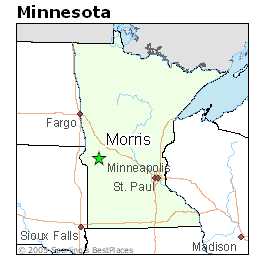 What's to become of this? It's our old school property in Morris. (B.W. photo)
What's to become of this? It's our old school property in Morris. (B.W. photo)Elwood P. Dowd had an imaginary giant rabbit friend in the 1950 movie "Harvey." Having an imaginary friend is something we usually associate with children. It can happen with adults too as we are apparently seeing with at least some adults in Morris now.
Their imaginary friend is the "green community" which occupies the old school property.
Think you just see a big grassy expanse of land with some vestigial evidence of school life? If you do, you're like me. The "green community" of enlightened souls in their happy homes of low consumption is so real to some, it's winning awards.
The local print media informed us Saturday that the landscaping feature is in the award spotlight. Specifically this award went to an entity called "The Morris Affordable Green Neighborhood Master Plan."
Jimmy Stewart played the character Elwood P. Dowd, and I can just see our local equivalent accepting this award at the annual banquet of the Minnesota chapter of the American Society of Landscape Architects. This fete is set for April 23 in Minneapolis.
I can't predict the future, but I just can't believe there is a substantial need for new housing in this community! As for the people who really do want to build new, would they really choose this location?
In the last few years, haven't most people chosen to build on the eastern fringes of the community, out near the bypass and the bike path that skirts the Pomme de Terre River in such an aesthetically pleasing way?
What are the aesthetics of the old school property? I don't see any redeeming features, so correct me if I'm wrong. The Summit Cemetery chime music would waft over your home. To the west you'll be treated to the site of the big, totally abandoned old school complex, unless the city can suddenly find the funds to tear it down.
Local government isn't swimming in money these days, is it?
But won't this decaying hulk of a building complex have to be dealt with sometime? Don't people shake their heads as they drive past it?
Friend Glen Helberg has repeatedly told me, while we share breakfast at McDonald's, that the funds for demolishing the old school should have been included in the package for building the new school. I agree, and absent that, there should have been some guarantee of re-use of the old building and property (at least part of it).
It's a tragedy for the art deco auditorium to be crumbling away. That auditorium is attached to the anchor structure of the complex, ironically the oldest part, built in 1914. And certainly this anchor building could have had its interior refurbished for some type of meaningful new use.
I've always suggested it's a shame the Stevens County Museum couldn't have relocated there.
The museum stayed at the old Carnegie building which by itself was worthless in terms of interior space. The Carnegie building was a striking landmark only on the outside. And that wasn't reason enough to preserve it. Much money was poured into constructing an "addition" which for all practical purposes constitutes (or could have constituted) the whole museum.
The museum is in residential west Morris which is an out-of-the-way place. It has no parking provisions so cars are lined up along residential curbs whenever there's a special event.
The old school property in east Morris is one of those open spaces that city planners actually like. Isn't it true that in most cities, parks are mandated at certain intervals in order to promote a healthy overall environment? Eastside Park is a short jog from the old school property and it's less of an open space than when I was a kid, due to that hulk of a bandshell (the Killoran music stage) which sits cold and silent for the vast majority of the year.
It appears that our city leaders aren't comfortable with the old school property as one of those open spaces. The city manager has stated that he wants to see this land "back on the tax rolls." This would seem to require some sort of net increase in population or business activity in Morris. Does that appear to be on the horizon?
Again, no one can predict the future, but one might argue for prudence based on the current realities. One of those realities might be that we were misguided in approving of the new school and football field in the first place.
At least, one could argue that the new school reflected an overly grandiose vision. It was sold to the voters on the basis of "we need a new elementary school." But what we got was so much more than that.
We now have a school that before long might appear dated - one of the generation of schools that in appearance can be likened to a big prison on the outskirts of town. I'm not the one who coined the "prison" comparison. Credit for that goes to a current school board member who was describing the new schools in general, not ours specifically (although he/she might have been).
Meanwhile our old, abandoned school, big enough by itself, just sits there as a suggestion of blight overlooking that expansive empty space which once was a playground, and where the Tiger football team would practice and play its games.
In a conversation I had with a different school board member, he/she told me - I'm keeping them anonymous - we will probably never again see the "town square" atmosphere that marked football games at Coombe Field. That atmosphere cannot be duplicated at Big Cat Field.
Attendance at Big Cat for Tiger football has appeared to drop since its opening. We're supposed to be happy about this? Is this progress?
We were told during the "vote yes" drive that these new facilities were so important for attracting new residents to Morris. Has there been any growth in the population or economy? The prevailing signs have in fact seemed negative.
The residents of a new "green community" would probably just be transplants from other parts of town and not newcomers. Would that add to the tax rolls?
Will our monstrous new school complex end up being an asset at all? We have been through a period in which bigger has been equated with better, and "build new" has been like a mantra with a stigmatizing effect on more conservative people who might like to just renovate what we have.
The advocates of "vote no" were put on the defensive. But time might vindicate them. Saturday's Star Tribune (actually called "Early Sunday") reported "state educators and policymakers say the financial outlook for schools in Minnesota is as bleak as it's been in at least a generation, as a host of budget-busting factors converge."
This might not be just one of those cyclical revenue issues either. Demographics are involved in a big way.
"Voters whose children are grown and whose incomes have shriveled will be less likely to approve requests to hike their property taxes," the article asserted.
It was added that the recession isn't the cause. There is a firm trend of diminishing funds and smaller enrollment. We've seen four-day school weeks in some places.
Some say this move and others like it are nothing more than Band-Aids. Truly innovative thinking is going to have to come into play. The problem might be compounded in Morris because we have two monstrosities: the sprawling new school with its aspects of opulence (e.g. the concert hall) and the haunted old one.
Unless some big new industries start up here, we could be in a world of hurt. Experts are saying that the excrement won't really start hitting the fan until the 2011-12 school year. Federal stimulus dollars will dry up.
"It's scary," says Scott Croonquist, head of the Association of Metropolitan School Districts, quoted in the Star Tribune article.
Look for more headlines about school closings, increased class sizes and tense issues to be resolved with teachers' professional associations. Sports will have to go under a microscope.
Many people are skeptical about shoveling more money at schools. "Money pits" is how they are seen by many, according to the Star Tribune.
That reminds me of a quote attributed (not publicly) to a former Morris Area school board member, someone imbued with that healthy skepticism. Reacting to a plea for more funds, he/she (anonymity again) told someone in an informal conversation that "if you give us the money, we'll just spend it."
That's priceless.
My top suggestion has been to creatively move away from the old education model and have kids learn more online. This continues a primary theme of this website. We've barely seen the start of how the Internet will change our world. Education might actually be enhanced and with a significant cost savings.
But will our old "prison" type schools be rendered as costly dinosaurs? I feel they might be.
The Star Tribune cited a popular suggestion of having "more but smaller schools, which might realize significant savings by partnering with other organizations to offer arts and sports."
The article then took some words right out of my mouth, stating that "smaller schools create a strong sense of community and accountability, which in turn minimizes discipline and learning problems."
The term I have often used in sharing this thought is "neighborhood schools."
Our old school in Morris was nestled in a cozy, friendly neighborhood setting. I think there is much to be said for this as opposed to the "prison" model.
But our old school and old "town square" football field are apparently gone with the wind. Subconsciously a lot of people may share my interpretation of all this, but in their denial they have come up with their "imaginary friend" of the "green community," a la "Harvey" in the Jimmy Stewart movie.
I fear this movie might not have a happy ending.
-Brian Williams - Morris mn Minnesota - bwilly73@yahoo.com






















No comments:
Post a Comment